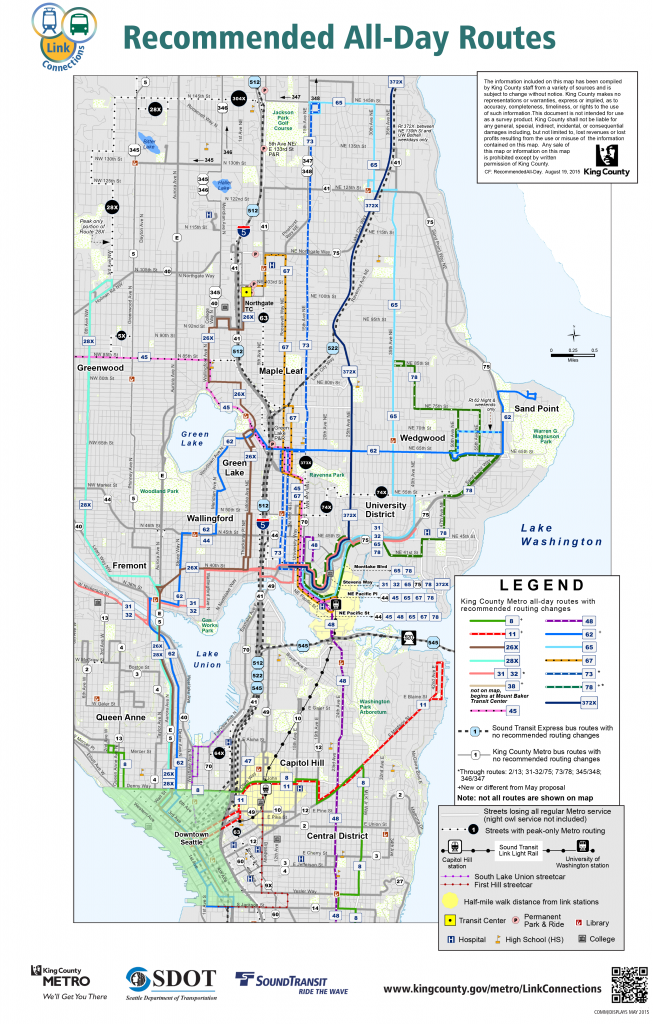On Tuesday, King County Executive Dow Constantine transmitted his recommendations for connecting new light rail stops with Seattle bus routes to the County Council. The recommendations come after nine months of public feedback and detailed input from a community Sounding Board, on which I sat. The goal was to come up with a refreshed bus network that will complement, and not duplicate, light rail service and provide more frequent service to a greater number of Seattle residents. Previous alternatives were narrowed down to this proposal. Some sacrifices had to made in geographical and temporal coverage, and some issues like inconvenient transfers remain. The King County Council is now accepting feedback on the final ordinance that will put the changes into effect early next year.

The details of the final ordinance will be covered when it is finalized this fall. The highlights of the recommended changes, developed through community feedback and the technical expertise of Metro staff, are listed below. Detailed maps and timetables are available for Northeast Seattle (PDF) and Central Seattle/Capitol Hill (PDF) on Metro’s U-Link Connections website.

- North of the Ship Canal and east of 20th Avenue NE
- Route 65 will see double the number of daily trips and will loop through the University of Washington (UW) campus, with Link riders transferring from Stevens Way.
- Route 372 will add new weekend service and evening service until midnight all week at least every 30 minutes.
- Route 78 is a new route that replaces part of the deleted Route 71 in the Wedgwood and View Ridge areas, but operate only during weekdays.
- Routes 64, 74, and 76 are peak-only and will receive more trips to offset the loss of one-seat rides downtown; Route 64 is revised to serve First Hill and South Lake Union
- East of I-5 and west of 20th Avenue NE
- Route 48/45 is a splitting of the Route 48, with an overlap between the UW station and NE 45th Street. Unfortunately, riders headed eastbound will be required to walk or take a short bus trip to the Montlake Freeway Station; an earlier proposal had the northern 48 through-route with the Issaquah-bound 271.
- Route 66 is revised as a peak-only route connecting Northgate to South Lake Union, Downtown, and First Hill.
- Route 67 is improved with 15 minute service between Northgate and the UW Link station. It is revised to run on Roosevelt Way and University Way, hitting the commercial centers of several neighborhoods.
- Route 70 is retained as is, preserving access from Eastlake to shopping in the University District and jobs in South Lake Union.
- Route 72 is deleted, with some offset with the revised Route 73. The Sounding Board suggested adding a Sound Transit 522 stop at NE 80th Street on Lake City Way to preserve service between the Maple Leak and Lake City neighborhoods.
- Route 73 is revised as a weekday-only route continuing to serve 15th Avenue NE and also the Roosevelt couplet in the University District. It connects to the UW Link station and through-routes with the Route 78.
- North of Lake Union and west of I-5
- Route 62 is a new east-west spine connecting many northern neighborhoods with Downtown and South Lake Union. It runs from Sand Point along NE 65th Street down through Fremont, and then takes Dexter into downtown. Service is recommended to be 15 minutes or more most of the week.
- Route 26/26X is extended northward to Northgate Transit Center via NE 92nd Street and 1st Avenue NE. It will also run along Aurora Avenue instead of through Fremont, improving reliability hampered by bridge openings.
- Route 28 is shifted onto Aurora Avenue, the same as Route 28X.
- Capitol Hill
- Route 8 is split at Mount Baker Transit Center to improve reliability, with a new Route 38 taking up the southern leg; the 8 will still be plagued by congestion on the Denny Way corridor.
- Routes 9 and 60 were not addressed in this restructure, but the Sounding Board expressed disappointment that service is being duplicated between Rainier Valley, Beacon Hill, and Capitol Hill.
- Route 11 is rerouted to Capitol Hill Station via Thomas Street/John Street/Olive Way, the highest ridership portion of the deleted Route 43, but follows Madison Street between 19th Avenue E and 24th Avenue E due to community feedback. It represents a compromise between providing Madison Park access to Link and a one-seat ride to Downtown.
- Route 12 is retained after a previous proposal to delete it despite its low performance at its tail.
- Route 25 is deleted due to its low performance.
- Route 49 is retained, but the Sounding Board expressed that it provides excessive service on the Pike/Pine corridor and between Capitol Hill and the University District.
- Eastside
- Sound Transit will create a new Route 541 with weekday peak-only trips between Overlake and the University District. Some Route 545 trips will be converted to Route 542 trips, and Route 540 will provide faster trips via I-405 and the Houghton Park and Ride.
More details on the recommendation are available on the U-Link Connections website. Discussion on stops, street infrastructure, and the transit user experience under this revised system will come with the King County Council’s final action this fall. Send feedback to the County Council and stay tuned for further details.
Scott Bonjukian has degrees in architecture and planning, and his many interests include neighborhood design, public space and streets, transit systems, pedestrian and bicycle planning, local politics, and natural resource protection. He cross-posts from The Northwest Urbanist and leads the Seattle Lid I-5 effort. He served on The Urbanist board from 2015 to 2018.



